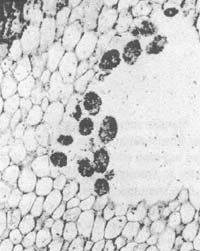Antarctic shit
The idea of coprolites as an explanation for tiny dark clots often seen
within fossil plant tissue became increasingly popular among
palaeontologists in the 1990s. Quite a number of
papers related the clots to oribatid mites. However, a large
fraction of those papers, or even most of them, will turn out
erroneous. No expert knowledge is required to find out, only common
sense and a close look at the published pictures. This is demonstrated
here with pictures from an often quoted paper on fossil plant tissue
from Antarctica [1].
The various sizes and shapes of the dark clots within damaged tissue in
Fig.1 agree remarkably well with the sizes and shapes of the nearby
cells.

Fig.1: Transverse section through a Triassic fern
petiole with partially damaged tissue and dubious "coprolites" whose
sizes and shapes agree with those of the cells. Picture after [1].
Below: enlarged detail.

This obvious coincidence, which gives a clue to a quite different
explanation, is not noticed by the authors [1] (nor by those of other
papers on alleged mite coprolites). Instead, they ponder about the
question why most of the cavity is empty in Fig.1 but filled in Fig. 2,
which does not lead anywhere.

Fig.2 (right): Oblique section of Triassic wood with
clots
whose shapes vary between distinctly angular and elliptical, after [1].
Evidently, the interpretation as coprolites in [1] is not compatible
with the shapes.
Apparently the tissue in Fig.2 collapsed
after clot formation and before silicification so that the sizes and
shapes of the clots cannot be compared with those of the cells in this
sample. At first sight it is puzzling that some clots are distinctly
angular but others distinctly rounded. However, this feature, too, is
compatible with the assumption deduced from Fig.1 that the clots are
modelled after the cell lumina, as seen on the enlarged clip from
Fig.1, where there is a series of distinctly angular cells (lower left
quarter of the picture) next to cells whose inner outline is clearly
rounded (above).
So one arrives at the inevitable conclusion that the clots are no
coprolites but objects closely related to the cells. As a probable
explanation, the cells were invaded by some fungus growing into a dense
tangle of tiny hyphae inside, a phenomenon known as arbuscular
mycorrhiza, after which the cell walls decayed and the clots remained.
See also Rhynie
Chert News 28.
In the light of these findings, some speculations advanced
in the
coprolite papers get a funny touch: For example, it is thought that the
larger cavities in the tissue are so spacious because they were
inhabited by several oribatid mites at the same time [1]. The presence
of two sizes of clots in one fossil sample is not attributed to the two
different tissues seen there but to two oribatid mite species [2].
Other evidence
contradicting the interpretation of cell-size clots as mite coprolites
has been spread among the palaeobotany community from 2007 on.
Nevertheless, more papers on misinterpreted clots appeared since 2010:
[3-7].
Carelessness in the scientific literature serves as an encouragement
for
carefully observing lay palaeontologists to provide surprising
revelations.
H.-J.
WEISS 2009,
updated 2011, 2013, 2015
[1] D.W. Kellog, E. L. Taylor:
Evidence of oribatid
mite detrivory in Antarctica during the Late Paleozoic and Mesozoic,
J. of Paleontology 78(2004), 1146-53.
[2] R. Rößler:
The late palaeozoic tree fern
Psaronius - an ecosystem unto itself,
Rev. Palaeobot. Palyn.
108(2000), 55-74. See comment.
[3]
Zhuo Feng, Jun Wang, Lu-Yun Liu :
First report of
oribatid mite (arthropod) borings and coprolites in Permian woods from
the Helan Mountains of northern China.
Palaeogeography,
Palaeoclimatology, Palaeoecology 288(2010),
54-61. See comment.
[4] M.
Barthel, M. Krings, R. Rößler: Die
schwarzen Psaronien
von Manebach, ihre Epiphyten, Parasiten
und Pilze.
Semana* 25(2010),
41-60. * recently re-named, former
name: Veröff. Naturhist. Mus. Schleusingen.
See comment.
[5]
N.A. Jud, G.W. Rothwell, R.A. Stockey:
Paleoecological and phylogenetic implications of Saxicaulis
meckertii ... :
A bennettitalean stem from the Upper
Cretaceous ...
Int J. Plant Sci. 171(2010), 915-25.
See comment.
[6] C.
Strullu-Derrien, S. McLoughlin, M. Philippe, A. Mørk, D.G. Strullu:
Arthropod interactions with
bennettitalean roots in a Triassic permineralized peat from Hopen,
Svalbard.
Palaeogeography, Palaeoclimatology,
Palaeoecology 348–349(2012), 45-58. See
comment.
[7] Zhuo
Feng,
J.W. Schneider, C.C.
Labandeira, R. Kretzschmar, R.
Rößler: A specialized feeding habit of Early
Permian oribatid mites.
Palaeogeography,
Palaeoclimatology, Palaeoecology 417(2015), 121-124. See
comment.
|

|
 11 11 |

 11
11



 11
11